Analysis of the Effects of Strengthening Building Energy Policy on Multifamily Residential Buildings in South Korea
Abstract
:1. Introduction
2. Building Envelope Requirements of Korean Building Energy Policies
3. Effects of Building Envelope Requirements on Building Energy Performances
3.1. Methodology
3.2. The Building Energy Simulation Models
3.3. Shape Factors of Korean Public Multifamily Residential Buildings
- Aen: Building envelope area [m2]
- Ahf: Heated floor area [m2]
- Vbldg: Building volume [m3]
3.4. Energy Demand Intensity for Different Building Envelope Requirements
3.5. Correlation between Building Energy Performances and Building Envelope Requirements
- Uw.avg.: Area-weighted average U-value [m2]
- Uen,i: U-value of building envelope element [m2]
- Aen,i: Area of building envelope element [m2]
- a: Slope of a linear regression model
- b: Y-intercept of a linear regression model
3.6. Potential Building Energy Use Savings
4. Summary and Conclusions
Author Contributions
Funding
Acknowledgments
Conflicts of Interest
References
- Ministry of Environment of the Republic of Korea. The Revised Plan of the National Roadmap for Greenhouse Gas Reductions by 2030 and the Plan for the National Greenhouse Gas Emission Permit Allocation from 2018 to 2020 are Finalized. Available online: http://eng.me.go.kr (accessed on 11 September 2019).
- National Law Information Center of the Korean Government. The Building Design Criteria for Energy Saving. Available online: http://www.law.go.kr/ (accessed on 11 September 2019).
- Korea Institute of Civil Engineering and Building Technology (KICT). Green Standard for Energy and Environmental Design (G-SEED). Available online: http://gseed.greentogether.go.kr (accessed on 11 September 2019).
- Korea Energy Agency, Building Energy Efficiency Certification. Available online: http://www.energy.or.kr (accessed on 11 September 2019).
- Statistics Korea (KOSTAT) of the Korean Government. 2017 Population and Housing Census. Available online: http://kostat.go.kr (accessed on 11 September 2019).
- Korea Energy Economics Institute. Yearbook of Energy Statistics; Korea Energy Economics Institute: Ulsan, Korea, 2018. [Google Scholar]
- Baek, C.; Park, S. Policy measures to overcome barriers to energy renovation of existing buildings. Renew. Sustain. Energy Rev. 2012, 16, 3939–3947. [Google Scholar]
- Tae, S.; Shin, S. Current work and future trends for sustainable buildings in South Korea. Renew. Sustain. Energy Rev. 2009, 13, 1910–1921. [Google Scholar]
- Evans, M.; Chon, H.; Shui, B.; Lee, S.-E. Country Report on Building Energy Codes in Republic of Korea; Pacific Northwest National Laboratory of the U.S. Department of Energy: Richland, WA, USA, 2009.
- Chandel, S.S.; Sharma, A.; Marwaha, B.M. Review of energy efficiency initiatives and regulations for residential buildings in India. Renew. Sustain. Energy Rev. 2016, 54, 1443–1458. [Google Scholar]
- Kwag, B.C.; Adamu, B.M.; Krarti, M. Analysis of high-energy performance residences in Nigeria. Energy Effic. 2018, 12, 681–695. [Google Scholar]
- Heravi, G.; Qaemi, M. Energy performance of buildings: The evaluation of design and construction measures concerning building energy efficiency in Iran. Energy Build. 2014, 75, 456–464. [Google Scholar]
- Ihm, P.; Krarti, M. Design optimization of energy efficient residential buildings in Tunisia. Build. Environ. 2012, 58, 81–90. [Google Scholar]
- Sadineni, S.; France, T.M.; Boehm, R.F. Economic feasibility of energy efficiency measures in residential buildings. Renew. Energy 2011, 36, 2925–2931. [Google Scholar]
- Ihm, P.; Park, L.; Krarti, M.; Seo, D. Impact of window selection on the energy performance of residential buildings in South Korea. Energy Policy 2012, 44, 1–9. [Google Scholar]
- Yoo, H.C.; Oh, Y.H.; Park, S.K. The optimal window system of office buildings considering energy efficiency. J. Korean Sol. Energy Soc. 2005, 25, 53–60. [Google Scholar]
- Han, S.H.; Kim, G.T.; Cho, G.H.; Kim, J.Y. A study on the Analysis of the Energy Saving Potential of Existing Apartment Houses Considering Insulation Performance and Construction Cost. J. Korean Inst. Archit. Sustain. Environ. Build. Syst. 2017, 11, 37–44. [Google Scholar]
- Park, D.J.; Yu, K.H.; Yoon, Y.S. Analysis of a Building Energy Efficiency Certification System in Korea. Sustainability 2015, 7, 16086–16107. [Google Scholar]
- Ministry of Land. Infrastructure and Transport, Zero Energy Construction, Now from Buildings to Cities! 2019. Available online: http://www.molit.go.kr/english/USR/BORD0201/m_28286 (accessed on 10 April 2020).
- Zero Energy Building, Zero Energy Building Certification. Available online: https://zeb.energy.or.kr (accessed on 10 April 2020).
- Korea Energy Agency. The Manual of the Building Design Criteria for Energy Saving; Building & Transportation Energy Management Division of Korea Energy Agency: Ulsan, Korea, 2017. [Google Scholar]
- Korea Energy Agency. The Operational Regulations of the Building Design Criteria for Energy Saving; Korea Energy Agency: Ulsan, Korea, 2016. [Google Scholar]
- The Building Codes Assistance Project. International Code Status: South Korea. Available online: http://bcapcodes.org/ (accessed on 11 September 2019).
- Lawrie, L.K.; Drury, B.C. Development of Global Typical Meteorological Years (TMYx). 2019. Available online: http://climate.onebuilding.or (accessed on 10 March 2020).
- Bae, C.H.; Kim, S.B.; Park, C.H.; Choo, S.Y. Studies on Effectiveness Proof of Green Building Certification through the Quantitative Analysis of Environmental Performance of Multi-residential Buildings. J. Archit. Inst. Korea Plan. Des. 2016, 32, 145–154. [Google Scholar]
- Roh, S.; Tae, S.; Kim, R. Developing a Green Building Index (GBI) Certification System to Effectively Reduce Carbon Emissions in South Korea’s Building Industry. Sustainability 2018, 10, 1872. [Google Scholar]
- Lim, H.; Tae, S.; Roh, S. Analysis of the Primary Building Materials in Support of G-SEED Life Cycle Assessment in South Korea. Sustainability 2018, 10, 2820. [Google Scholar]
- Oh, T.K.; Lee, D.; Park, M.; Cha, G.; Park, S. Three-Dimensional Visualization Solution to Building-Energy Diagnosis for Energy Feedback. Energies 2018, 11, 1736. [Google Scholar]
- Kim, C.S. The Influence of Unit Plan Shapes to the Energy Efficiency of Collective Housing Simulated by ECO2 Software. Korea Inst. Ecol. Archit. Environ. J. (KIEAE J.) 2015, 15, 89–94. [Google Scholar]
- Lee, A.R.; Kim, J.G.; Kim, J.H.; Jeong, H.G.; Jang, C.Y.; Song, K.D. Comparing the actual heating energy with calculated energy by the amended standard building energy rating system for apartment buildings. Korea Inst. Ecol. Archit. Environ. J. (KIEAE J.) 2015, 15, 103–107. [Google Scholar]
- Kwon, J.H.; Jang, H.I.; Kim, M.K.; Park, H.S.; Suh, S.J. Comparison on the Annual Energy Demand by Building Energy Assessment Tool and Dynamic Energy Simulation. In Proceedings of the 2012 Summer Conference of the Society of Air-Conditioning and Refrigerating Engineers of Korea, Pyeongchang, Korea, 27–29 June 2012; pp. 363–366. [Google Scholar]
- Kim, S.H.; Kwak, Y.H.; Kim, C.S. The Analysis on Energy Performance of Collective Housing using ECO2 and DesignBuilder Softwares. Korea Inst. Ecol. Archit. Environ. J. (KIEAE J.) 2018, 18, 47–54. [Google Scholar]
- Korea Land & Housing Corporation. Available online: https://www.lh.or.kr/eng/index.do (accessed on 10 March 2020).
- K-APT, Energy Use Information. The Korea Appraisal Board. Available online: http://www.k-apt.go.kr/apiinfo/openCost.do? (accessed on 10 March 2020).
- NHBC Foundation. The Challenge of Shape and form; Understanding the Benefits of Efficient Design; The NHBC Foundation: Milton Keynes, UK, 2016. [Google Scholar]
- Kim, H.G.; Kim, M.Y. Optimal Design Techniques for Energy Performances of Apartment Housing; Seoul Housing & Communities Corporation: Seoul, Korea, 2016. [Google Scholar]
- Korea Energy Agency. Design Guideline for Building Energy Saving. Available online: http://building.energy.or.kr/build/CS/CSDMPage.do?page=542 (accessed on 10 March 2020).
- Hwang, H.J.; Kim, G.T.; Yoo, J.H.; Lee, J.S.; Lim, H.J.; Chang, G.S. Design Criteria Establishment of Performance in LH Apartments for Government Energy Policy; Korea Land & Housing Institute: Daejeon, Korea, 2016. [Google Scholar]
- Bean, R.; Olesen, B.W.; Kim, K.W. History of Radiant Heating & Cooling Systems: Part 1. ASHRAE J. 2010, 52, 40–47. [Google Scholar]
- Bean, R.; Olesen, B.W.; Kim, K.W. History of Radiant Heating & Cooling Systems: Part 2. ASHRAE J. 2010, 52, 50–55. [Google Scholar]
- Rhee, K.N.; Kim, K.W. A 50 year review of basic and applied research in radiant heating and cooling systems for the built environment. Build. Environ. 2015, 91, 166–190. [Google Scholar]
- Olesen, B.W. Control of floor heating and cooling systems. In Proceedings of the Clima 2000/Napoli 2001 World Congress, Napoli, Italy, 15–18 September 2001. [Google Scholar]
- New York City Energy Conservation Code. 2016 Energy Conservation Code. Available online: https://www1.nyc.gov (accessed on 30 September 2019).
- Korea Energy Agency. The Regulations of Building Energy Efficiency Certification; Korea Energy Agency: Ulsan, Korea, 2016. [Google Scholar]


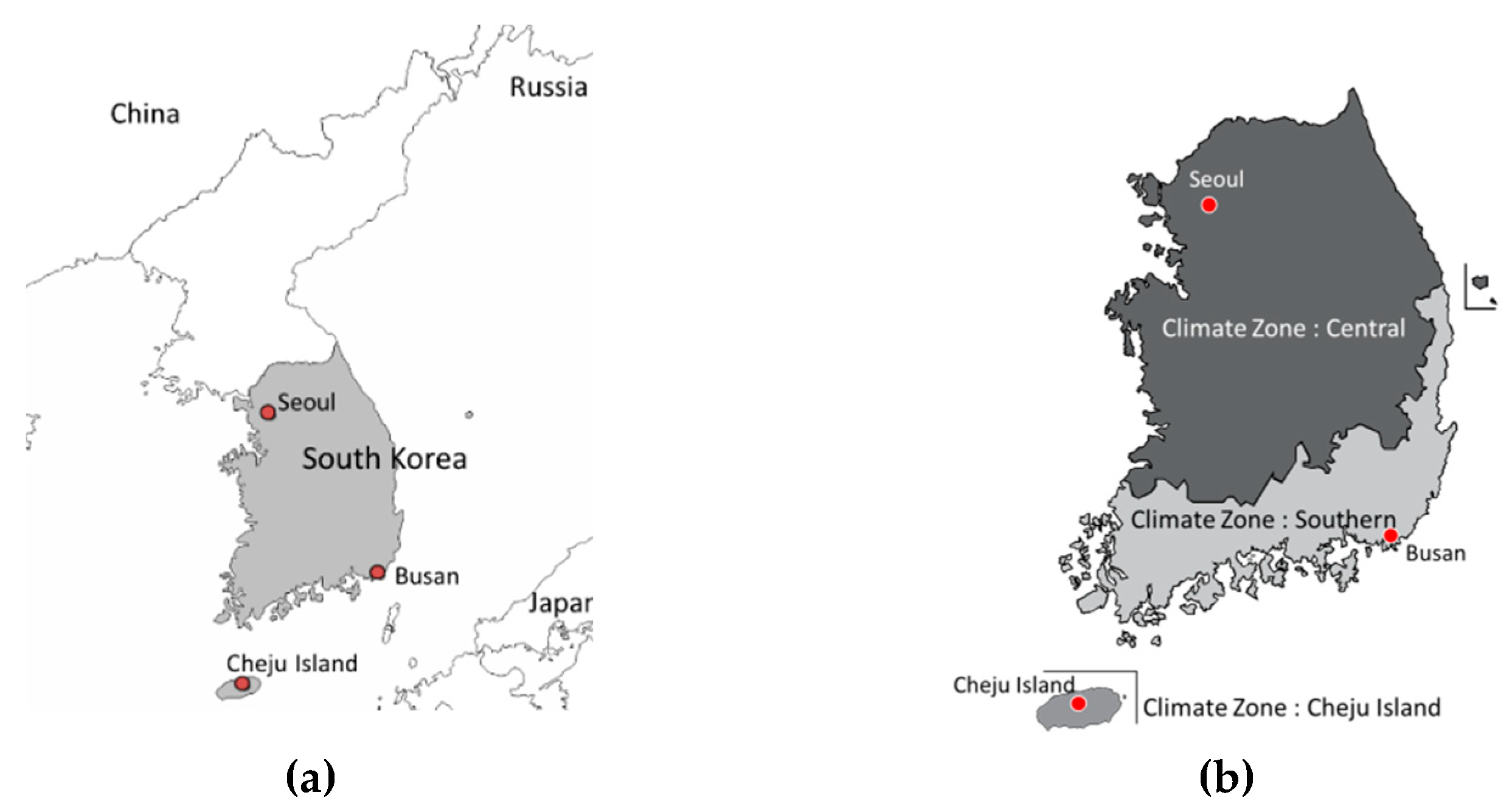
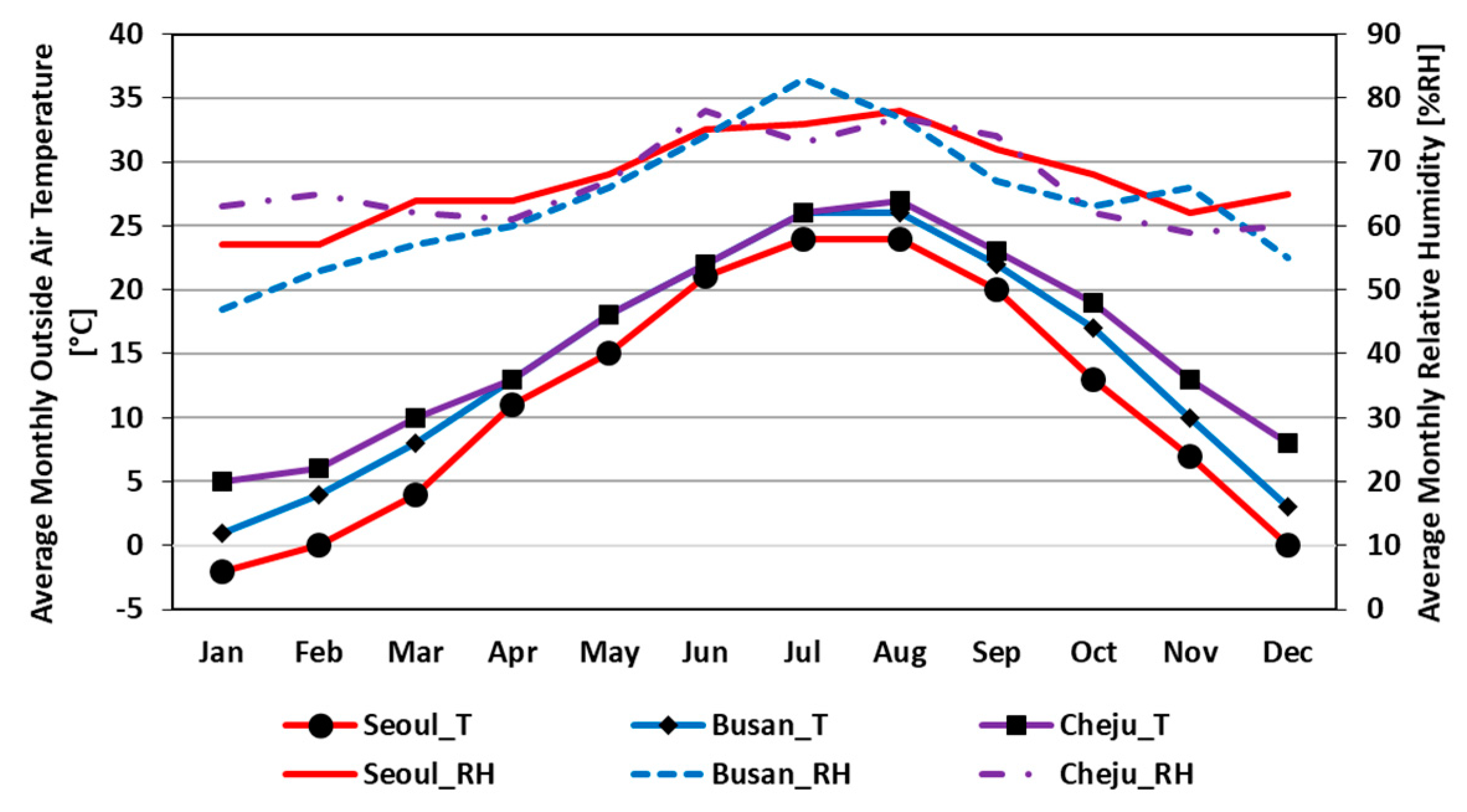


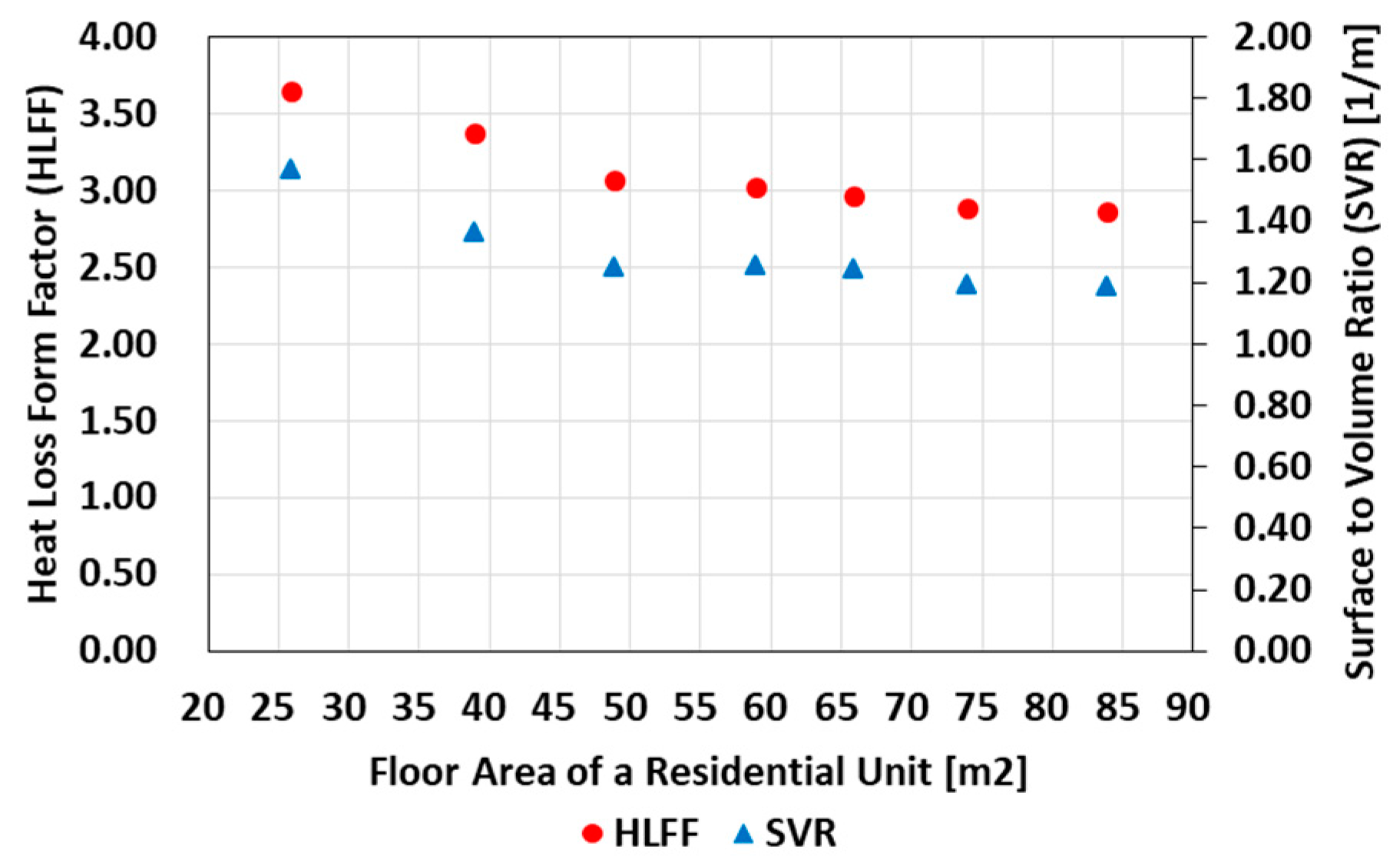

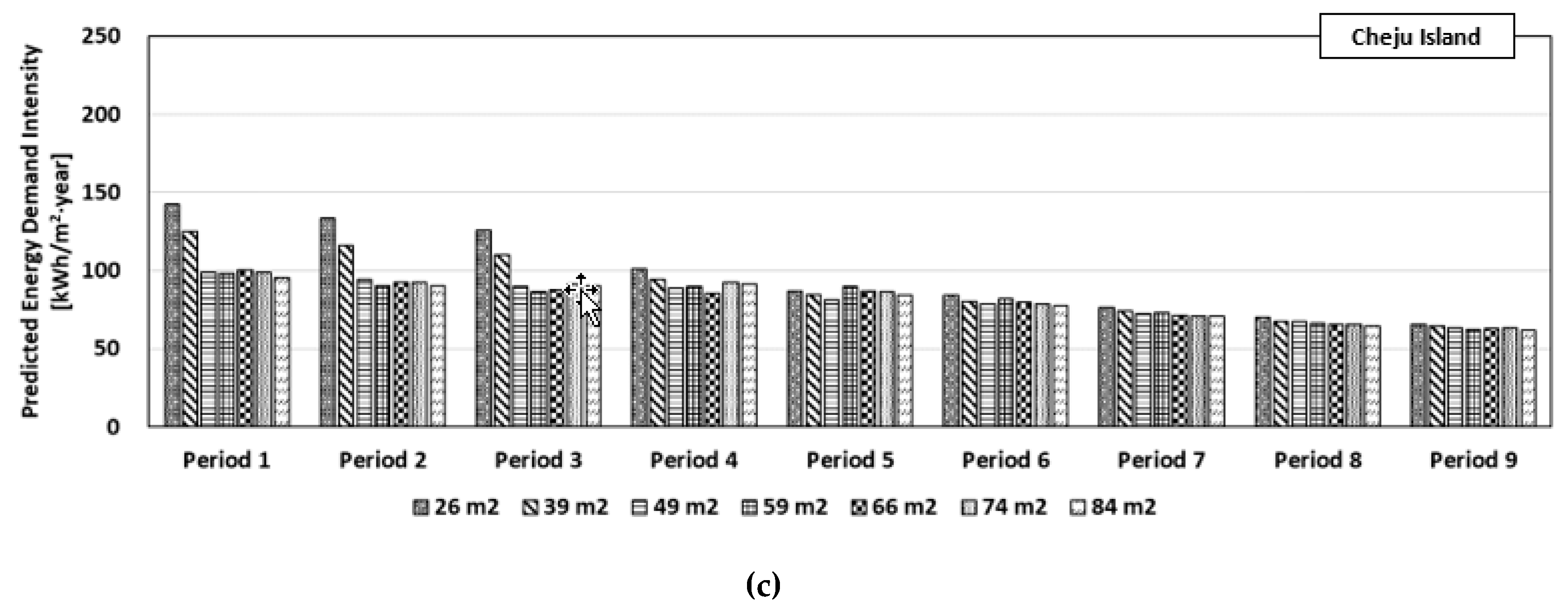
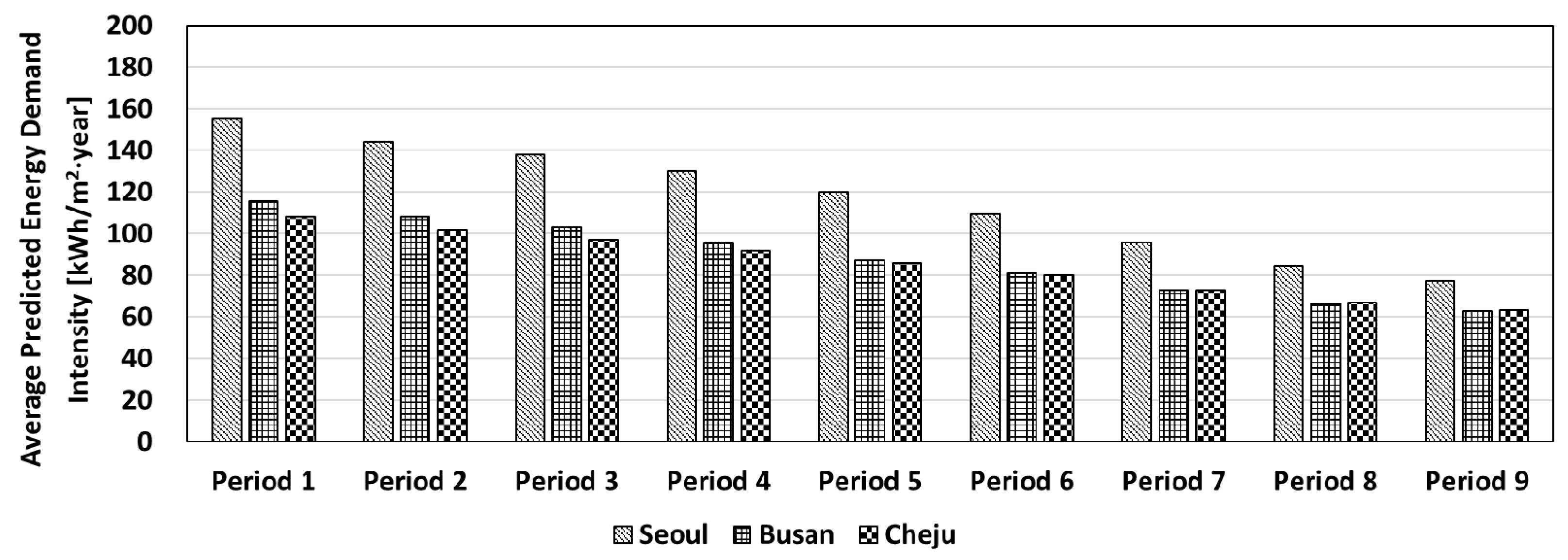

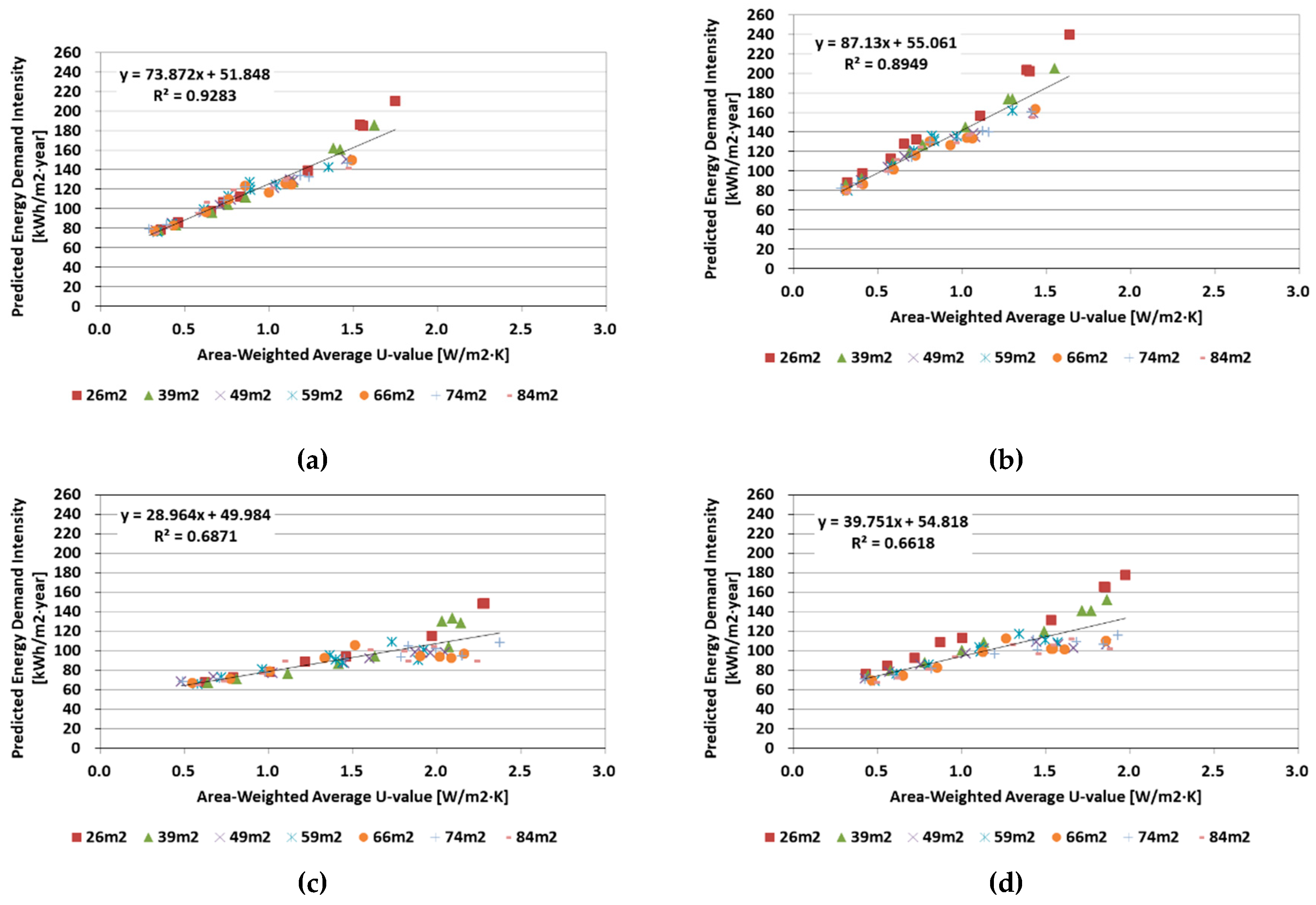

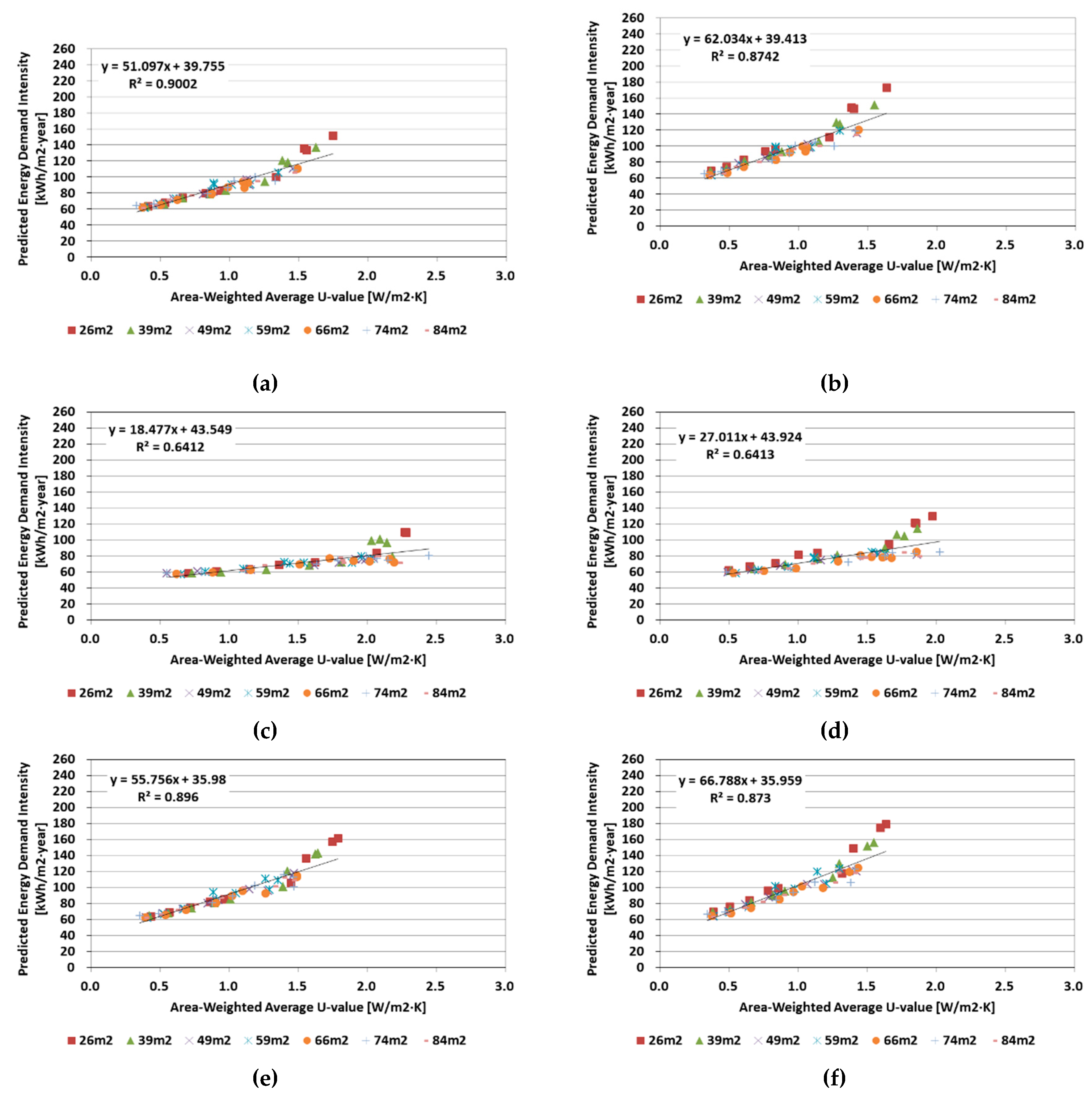
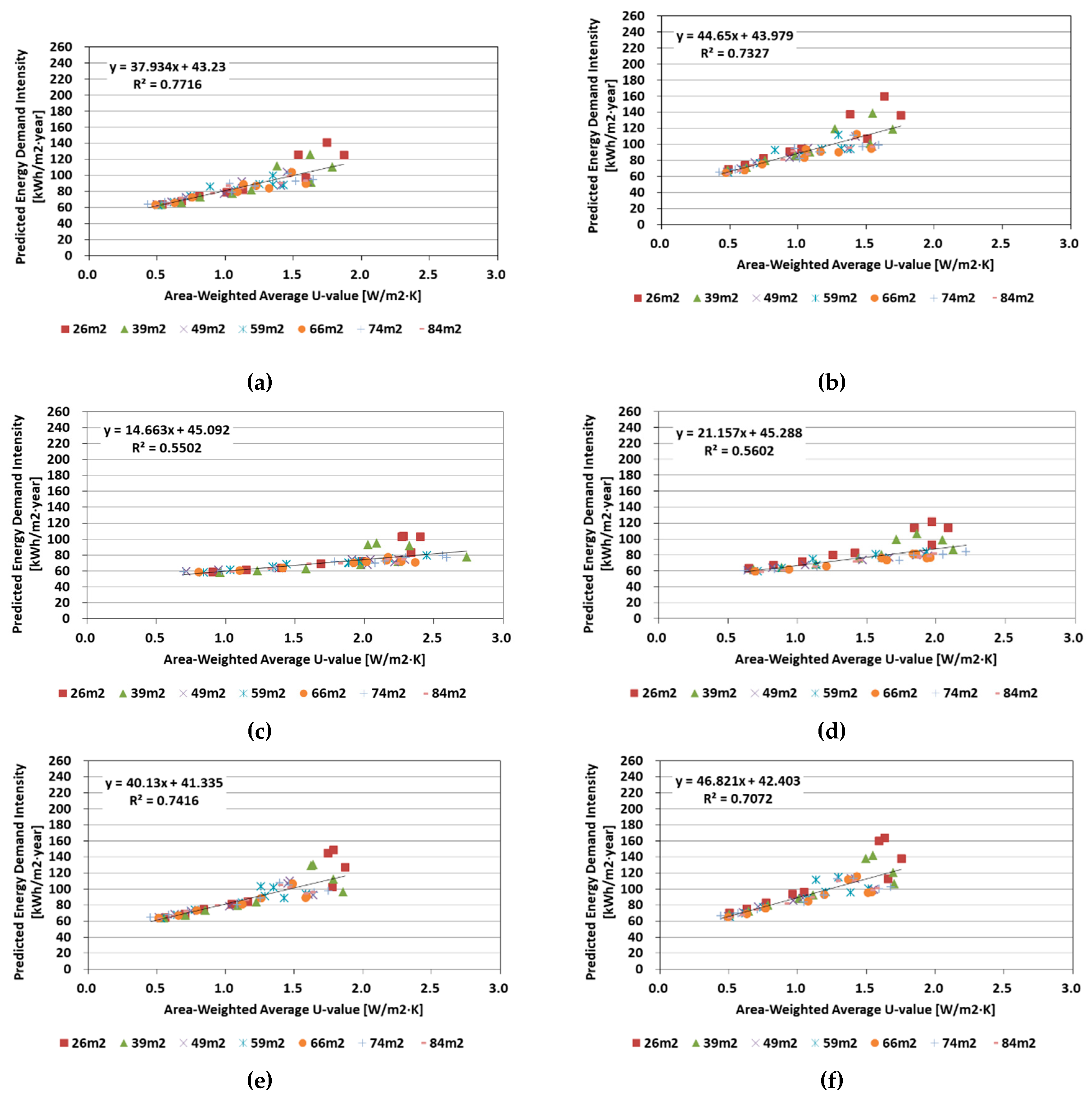
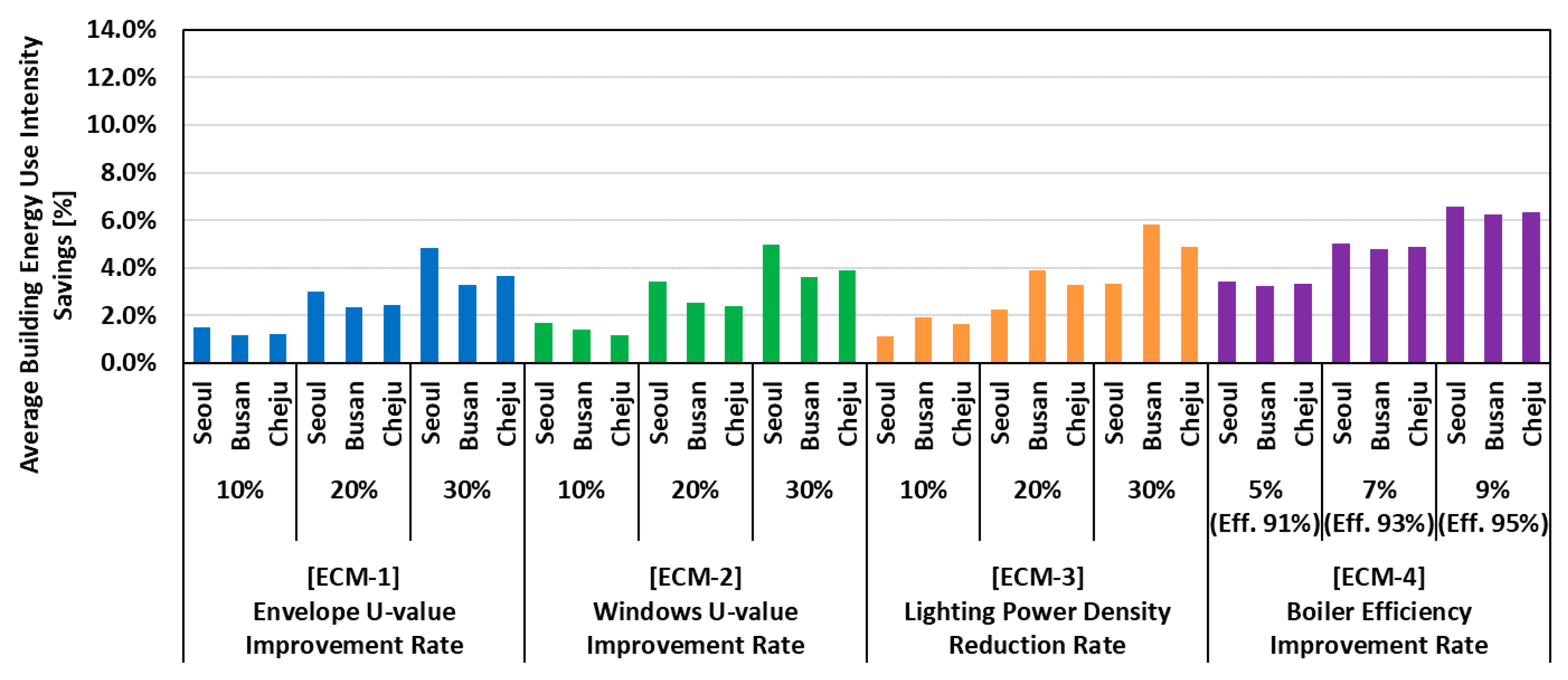

| Building Energy Efficiency Certification | Zero Energy Building Certification | ||
|---|---|---|---|
| Level | Primary Energy Use Intensity (kWh/m2∙year) | Level | Building Energy Independence Rate (%) |
| 1+++ | Less than 60 | 1 | More than 100% |
| 1++ | 60–90 | 2 | 80–100% |
| 1+ | 90–120 | 3 | 60–80% |
| 1 | 120–150 | 4 | 40–60% |
| 2 | 150–190 | 5 | 20–40% |
| 3 | 190–230 | ||
| 4 | 230–270 | ||
| 5 | 270–320 | ||
| 6 | 320–370 | ||
| 7 | 370–420 | ||
| Time | Climate Zone | Thermal Conductivity (U-value) [W/m2·K] | ||||||||
|---|---|---|---|---|---|---|---|---|---|---|
| Exterior Wall | Roof | Floor | Window | |||||||
| Direct | Indirect | Direct | Indirect | Direct | Indirect | Direct | Indirect | |||
| Period 1 | May 1979–December 1980 | All | 1.05 | - | 1.05 | - | 1.05 | - | 2.56 | - |
| Period 2 | January 1981–December 1984 | All | 0.58 | - | 0.58 | - | 1.16 | - | 3.49 | - |
| Period 3 | January 1985–July 1987 | Inland | 0.58 | - | 0.58 | - | 0.58 | - | 3.49 | - |
| Cheju Island | 1.16 | - | 1.16 | - | 1.16 | - | 3.49 | - | ||
| Period 4 | August 1987–January 2001 | Central | 0.58 | - | 0.41 | - | 0.58 | - | 3.37 | - |
| Southern | 0.76 | - | 0.52 | - | 0.76 | - | 3.60 | - | ||
| Cheju Island | 1.16 | - | 0.76 | - | 1.16 | - | 5.81 | - | ||
| Period 5 | February 2001–July 2008 | Central | 0.47 | 0.64 | 0.29 | 0.41 | 0.35 | 0.41 | 3.84 | 5.47 |
| Southern | 0.58 | 0.81 | 0.35 | 0.52 | 0.41 | 0.47 | 4.19 | 6.05 | ||
| Cheju Island | 0.76 | 1.10 | 0.41 | 0.58 | 0.47 | 0.58 | 5.23 | 7.56 | ||
| Period 6 | August 2008–November 2010 | Central | 0.47 | 0.64 | 0.29 | 0.41 | 0.35 | 0.52 | 3.00 | 4.30 |
| Southern | 0.58 | 0.81 | 0.35 | 0.52 | 0.41 | 0.58 | 3.30 | 4.70 | ||
| Cheju Island | 0.76 | 1.10 | 0.41 | 0.58 | 0.47 | 0.64 | 4.20 | 6.00 | ||
| Period 7 | December 2010–September 2013 | Central | 0.36 | 0.49 | 0.20 | 0.29 | 0.30 | 0.43 | 2.10 | 2.80 |
| Southern | 0.45 | 0.63 | 0.24 | 0.34 | 0.35 | 0.50 | 2.40 | 3.10 | ||
| Cheju Island | 0.58 | 0.85 | 0.29 | 0.41 | 0.35 | 0.50 | 3.10 | 3.70 | ||
| Period 8 | October 2013–January 2016 | Central | 0.27 | 0.37 | 0.18 | 0.26 | 0.23 | 0.35 | 1.50 | 2.20 |
| Southern | 0.34 | 0.48 | 0.22 | 0.31 | 0.28 | 0.40 | 1.80 | 2.50 | ||
| Cheju Island | 0.44 | 0.64 | 0.28 | 0.40 | 0.33 | 0.47 | 2.60 | 3.30 | ||
| Period 9 | February 2016–Present | Central | 0.21 | 0.30 | 0.15 | 0.22 | 0.18 | 0.26 | 1.20 | 1.60 |
| Southern | 0.26 | 0.37 | 0.18 | 0.26 | 0.22 | 0.31 | 1.40 | 1.80 | ||
| Cheju Island | 0.36 | 0.52 | 0.25 | 0.35 | 0.29 | 0.41 | 2.00 | 2.50 | ||
| Category | Seoul | Busan |
|---|---|---|
| Built Year | 2017 | 2016 |
| Energy Data | Space Heating | Space Heating |
| Unit Floor Area | 59 m2 (324 units) 74 m2 (160 units) 84 m2 (325 units) | 33 m2 (174 units) 39 m2 (88 units) 46 m2 (190 units) |
| Actual Data | 77.1 kWh/m2/year | 46.1 kWh/m2/year |
| Simulation Data | 70.2 kWh/m2/year | 48.8 kWh/m2/year |
| Percent Difference | 9.8% | 5.5% |
| Category | Setting |
|---|---|
| Number of Residential Units | 9-unit (3 units per floor) |
| Number of Floors | 3-story |
| Building Orientation | South |
| Floor-to-Ceiling Height | 2.3 m |
| Infiltration Rate | Air Change per Hour = 6 at 50Pa |
| Heating Set-point | 26.0 °C |
| Heating System Type | Radiant Heating Floor |
| Heating Source | Condensing Gas Hot-Water Boiler (Efficiency 87%) |
| Lighting Power Density | 13.0 W/m2 |
| Solar Heat Gain Coefficient | SHGC = 0.6 |
| Case | Case 1 | Case 2 | Case 3 | Case 4 |
|---|---|---|---|---|
| % Reduction in Area-Weighted Average U-value [W/m2] | 10% | 30% | 50% | 100% |
| Region | Household | Baseline | Calculated EDI (kWh/m2∙year) | Potential EDI Reduction (%) | |||||||
|---|---|---|---|---|---|---|---|---|---|---|---|
| Uw.avg. [W/m2] | EDI [kWh/m2∙year] | Case1 | Case2 | Case3 | Case4 | Case1 | Case2 | Case3 | Case4 | ||
| Seoul | Top-Middle | 0.33 | 77.38 | 73.51 | 68.69 | 63.88 | 51.85 | 5% | 11% | 17% | 33% |
| Middle-Middle | 0.56 | 67.09 | 64.56 | 61.32 | 58.08 | 49.98 | 4% | 9% | 13% | 25% | |
| Bottom-Middle | 0.34 | 78.71 | 73.85 | 68.52 | 63.18 | 49.83 | 6% | 13% | 20% | 37% | |
| Top-Side | 0.31 | 82.19 | 79.07 | 73.73 | 68.40 | 55.06 | 4% | 10% | 17% | 33% | |
| Middle-Side | 0.45 | 71.42 | 70.88 | 67.31 | 63.74 | 54.82 | 1% | 6% | 11% | 23% | |
| Bottom-Side | 0.32 | 83.55 | 79.80 | 73.96 | 68.13 | 53.55 | 4% | 11% | 18% | 36% | |
| Busan | Top-Middle | 0.37 | 62.52 | 56.98 | 53.15 | 49.32 | 39.76 | 9% | 15% | 21% | 36% |
| Middle-Middle | 0.63 | 57.76 | 54.07 | 51.73 | 49.39 | 43.55 | 6% | 10% | 14% | 25% | |
| Bottom-Middle | 0.40 | 63.24 | 55.91 | 51.48 | 47.05 | 35.98 | 12% | 19% | 26% | 43% | |
| Top-Side | 0.35 | 65.07 | 59.23 | 54.82 | 50.42 | 39.41 | 9% | 16% | 23% | 39% | |
| Middle-Side | 0.51 | 59.72 | 56.43 | 53.65 | 50.87 | 43.92 | 6% | 10% | 15% | 26% | |
| Bottom-Side | 0.37 | 65.83 | 58.43 | 53.44 | 48.44 | 35.96 | 11% | 19% | 26% | 45% | |
| Cheju Island | Top-Middle | 0.50 | 63.18 | 60.21 | 56.44 | 52.66 | 43.23 | 5% | 11% | 17% | 32% |
| Middle-Middle | 0.83 | 58.36 | 55.99 | 53.57 | 51.15 | 45.09 | 4% | 8% | 12% | 23% | |
| Bottom-Middle | 0.52 | 63.82 | 60.12 | 55.94 | 51.77 | 41.34 | 6% | 12% | 19% | 35% | |
| Top-Side | 0.47 | 65.63 | 63.01 | 58.78 | 54.55 | 43.98 | 4% | 10% | 17% | 33% | |
| Middle-Side | 0.68 | 60.35 | 58.19 | 55.32 | 52.46 | 45.29 | 4% | 8% | 13% | 25% | |
| Bottom-Side | 0.49 | 66.30 | 63.16 | 58.55 | 53.94 | 42.40 | 5% | 12% | 19% | 36% | |
| Energy Conservation Measure | Baseline | Options | |||
|---|---|---|---|---|---|
| ECM-1 | U-values of Walls, Roofs, Floors (W/m2·K) | Requirements in 2016 | 10% Reduced | 20% Reduced | 30% Reduced |
| ECM-2 | U-values of Windows (W/m2·K) | Requirements in 2016 | 10% Reduced | 20% Reduced | 30% Reduced |
| ECM-3 | Lighting Power Density (LPD) (W/m2) | 13 W/m2 | 10% Reduced (11.7 W/m2) | 20% Reduced (10.4 W/m2) | 30% Reduced (9.1 W/m2) |
| ECM-4 | Boiler Efficiency (%) | Eff. 87% | 5% Improved (Eff. 91%) | 7% Improved (Eff. 93%) | 9% Improved (Eff. 95%) |
| Climate Zones | Area-Weighted Average U-Value Reduction | |||||
|---|---|---|---|---|---|---|
| % Reduction in U-Value of Exterior Walls, Roofs, Floors | % Reduction in U-Value of Windows | |||||
| 10% | 20% | 30% | 10% | 20% | 30% | |
| Seoul | 5.0% | 10.1% | 15.1% | 5.0% | 9.9% | 14.9% |
| Busan | 5.4% | 10.7% | 16.1% | 4.6% | 9.3% | 13.9% |
| Cheju Island | 5.6% | 11.2% | 16.7% | 4.4% | 8.8% | 13.3% |
| ECM Option | Seoul [kWh/m2∙year] | Busan [kWh/m2∙year] | Cheju Island [kWh/m2∙year] | ||||||||||
|---|---|---|---|---|---|---|---|---|---|---|---|---|---|
| Space Heating | Hot Water | Interior Lighting | Sum | Space Heating | Hot Water | Interior Lighting | Sum | Space Heating | Hot Water | Interior Lighting | Sum | ||
| Baseline | 70.2 | 44.4 | 29.7 | 144.3 | 48.8 | 44.4 | 29.7 | 122.9 | 57.3 | 44.4 | 29.7 | 131.4 | |
| ECM1 | 10% reduced | 68.2 | 44.4 | 29.7 | 142.3 | 47.5 | 44.4 | 29.7 | 121.6 | 55.8 | 44.4 | 29.7 | 129.9 |
| 20% reduced | 66.3 | 44.4 | 29.7 | 140.4 | 46.1 | 44.4 | 29.7 | 120.2 | 54.3 | 44.4 | 29.7 | 128.4 | |
| 30% reduced | 64.1 | 44.4 | 29.7 | 138.2 | 45.1 | 44.4 | 29.7 | 119.2 | 52.8 | 44.4 | 29.7 | 126.9 | |
| ECM2 | 10% reduced | 67.9 | 44.4 | 29.7 | 142.0 | 47.2 | 44.4 | 29.7 | 121.3 | 55.7 | 44.4 | 29.7 | 129.8 |
| 20% reduced | 65.6 | 44.4 | 29.7 | 139.7 | 45.4 | 44.4 | 29.7 | 119.5 | 54.1 | 44.4 | 29.7 | 128.2 | |
| 30% reduced | 63.5 | 44.4 | 29.7 | 137.6 | 44.2 | 44.4 | 29.7 | 118.3 | 51.7 | 44.4 | 29.7 | 125.8 | |
| ECM3 | 10% reduced | 71.9 | 44.4 | 26.7 | 143.0 | 49.3 | 44.4 | 26.7 | 120.4 | 58.1 | 44.4 | 26.7 | 129.2 |
| 20% reduced | 73.3 | 44.4 | 23.7 | 141.4 | 49.9 | 44.4 | 23.7 | 118 | 58.9 | 44.4 | 23.7 | 127.0 | |
| 30% reduced | 74.8 | 44.4 | 20.8 | 140.0 | 50.5 | 44.4 | 20.8 | 115.7 | 59.7 | 44.4 | 20.8 | 124.9 | |
| 50% reduced | 78.1 | 44.4 | 14.8 | 137.3 | 52.3 | 44.4 | 14.8 | 111.5 | 61.4 | 44.4 | 14.8 | 120.6 | |
| ECM4 | Eff. 91% | 67.3 | 42.5 | 29.7 | 139.5 | 46.7 | 42.5 | 29.7 | 118.9 | 54.9 | 42.5 | 29.7 | 127.1 |
| Eff. 93% | 65.9 | 41.6 | 29.7 | 137.2 | 45.8 | 41.6 | 29.7 | 117.1 | 53.8 | 41.6 | 29.7 | 125.1 | |
| Eff. 95% | 64.5 | 40.7 | 29.7 | 134.9 | 44.9 | 40.7 | 29.7 | 115.3 | 52.7 | 40.7 | 29.7 | 123.1 | |
| Fuel | Conversion Factor |
|---|---|
| Electricity | 2.75 |
| Gas | 1.1 |
© 2020 by the authors. Licensee MDPI, Basel, Switzerland. This article is an open access article distributed under the terms and conditions of the Creative Commons Attribution (CC BY) license (http://creativecommons.org/licenses/by/4.0/).
Share and Cite
Kwag, B.C.; Han, S.; Kim, G.T.; Kim, B.; Kim, J.Y. Analysis of the Effects of Strengthening Building Energy Policy on Multifamily Residential Buildings in South Korea. Sustainability 2020, 12, 3566. https://doi.org/10.3390/su12093566
Kwag BC, Han S, Kim GT, Kim B, Kim JY. Analysis of the Effects of Strengthening Building Energy Policy on Multifamily Residential Buildings in South Korea. Sustainability. 2020; 12(9):3566. https://doi.org/10.3390/su12093566
Chicago/Turabian StyleKwag, Byung Chang, Sanghee Han, Gil Tae Kim, Beobjeon Kim, and Jong Yeob Kim. 2020. "Analysis of the Effects of Strengthening Building Energy Policy on Multifamily Residential Buildings in South Korea" Sustainability 12, no. 9: 3566. https://doi.org/10.3390/su12093566
APA StyleKwag, B. C., Han, S., Kim, G. T., Kim, B., & Kim, J. Y. (2020). Analysis of the Effects of Strengthening Building Energy Policy on Multifamily Residential Buildings in South Korea. Sustainability, 12(9), 3566. https://doi.org/10.3390/su12093566





